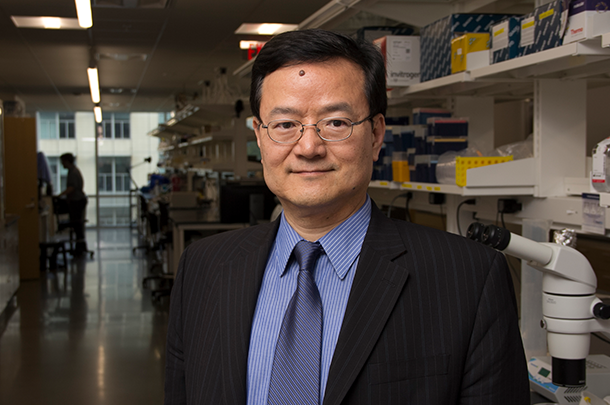Treating the deep brain with ultrasound
More than 100,000 patients have been implanted with a deep brain stimulator—a device like a cardiac pacemaker for the brain—but Bin He is searching for a noninvasive alternative. He’s most recent neuromodulation technology uses ultrasonic waves and EEG imaging, a method that has implications for Parkinson’s and Alzheimer’s disease.
For nearly 60 years, doctors have been using cardiac pacemakers to treat patients with abnormal heart rates, otherwise known as heart arrhythmias. These pacemakers—which consist of a battery, computerized generator, and multiple electrodes—send electrical pulses to the heart when they detect any kind of abnormal cardiac activity, like when the heart is beating too slow or too fast. In general, cardiac pacemakers help regulate a patient’s heart rate to make sure enough blood is being pumped to their vital organs.
In the early 1990s, more than 30 years after the advent of cardiac pacemakers, doctors began developing similar devices for the brain called deep brain stimulators—more commonly known as brain pacemakers. Deep brain stimulators consist of a generator (which is implanted in the chest) and a pair of electrodes that are implanted in the brain during brain surgery. Much like cardiac pacemakers, which regulate the heart’s electrical activity, deep brain stimulators regulate the electrical activity of the brain. Deep brain stimulators are highly effective because doctors can use them to target and stimulate only the parts of the brain that are malfunctioning. Today, doctors have used these devices to effectively treat Parkinson’s disease and to explore treating several other neurological disorders such as epilepsy and depression.
Although more than 100,000 patients have been implanted with a deep brain stimulator, many scientists and researchers, including Carnegie Mellon University’s Department Head of Biomedical Engineering Bin He, have been searching for an alternative, noninvasive way to achieve the same results. He may have found a viable solution with his most recent neuromodulation technology based on ultrasonic waves and electroencephalography (EEG) imaging, a method that has implications for both Parkinson’s and Alzheimer’s disease.
This research will have great clinical significance for patients suffering from diseases like Parkinson’s and Alzheimer’s.
Bin He, Department Head, Biomedical Engineering, Carnegie Mellon University
He’s neuromodulation method uses focused ultrasonic waves to simulate the brain and EEG-based source imaging to record and monitor the brain’s electrical activity. Ultrasound has long been used in medical practice, but it has only recently been demonstrated that low-intensity transcranial focused ultrasound can activate the electrical activity within a human’s brain. Since EEG offers high resolution images of the brain in real-time, He can use those detailed images to identify which parts of the brain are operating normally and which parts are malfunctioning. Once the defective parts of the brain are identified, He targets and stimulates those regions with ultrasonic waves to achieve normal brain activity.
With He’s innovative neuromodulation method, scientists will be able to understand how they could potentially use ultrasonic waves to inhibit or excite neurons in both healthy and unhealthy brains—an important feat for doctors hoping to treat patients with neurological disorders like Parkinson’s and Alzheimer’s disease. He’s method is highly promising because it may offer a noninvasive way to achieve the highly precise and effective results of Deep Brain Stimulation (DBS).
“Our noninvasive ultrasound method will let doctors deliver acoustic energy to very specific parts of the brain,” says He. “It has a level of focality that other noninvasive neuromodulation methods don’t have, and it can also penetrate deeper into the brain tissue. But, most importantly, it’s noninvasive, unlike Deep Brain Stimulation, which means it’s a reversible process.”

Source: Carnegie Mellon University College of Engineering
Bin He is Carnegie Mellon University’s Department Head of Biomedical Engineering.
With He’s method, an ultrasonic wave would be delivered as a beam through a wearable technology, somewhat like a swimming cap. Then, when the symptoms have been relieved, patients can choose to stop treatment—which won’t require an invasive surgery to remove a DBS implant.
“DBS is an effective form of treatment because it’s highly focalized, but it requires an invasive surgical procedure that’s irreversible,” explains He. “Noninvasive methods also exist, but they often lack high-spatial resolution, depth of penetration, and high focality. Now, through engineering innovation, we are aiming to develop a closed-loop, noninvasive, high-spatial, and high-temporal stimulation technology that promise to achieve, in the future, what DBS can do.”
To conduct his research, He received a four-year, $2.4M BRAIN Initiative grant from the National Institutes of Health (NIH). The National Institute of Mental Health and National Institute on Drug Abuse funded this work. BRAIN Initiative grants are awarded to individuals eager to develop new and innovative technologies that will offer revolutionary pictures of the brain, which will ultimately help scientists treat diseases like Alzheimer’s, Parkinson’s, and epilepsy by giving them the tools they need to understand how healthy and unhealthy brains function. A pioneer in the field, He is the editor of the first textbook on Neural Engineering, published in 2005.
“The BRAIN Initiative was launched to tackle advances in neurotechnology that will help scientists better understand the brain and provide doctors with the tools to manage brain diseases,” He says.
After conducting their initial studies, He and his students and faculty collaborators—including Maysam Chamanzar from the Department of Electrical and Computer Engineering, Alison Barth from the Department of Biological Sciences, and the University of Pittsburgh’s Kang Kim—intend to move into clinical trials.
“By the end of this grant, we hope to have technology ready for future clinical use,” says He. “This research will have great clinical significance for patients suffering from diseases like Parkinson’s and Alzheimer’s.”
